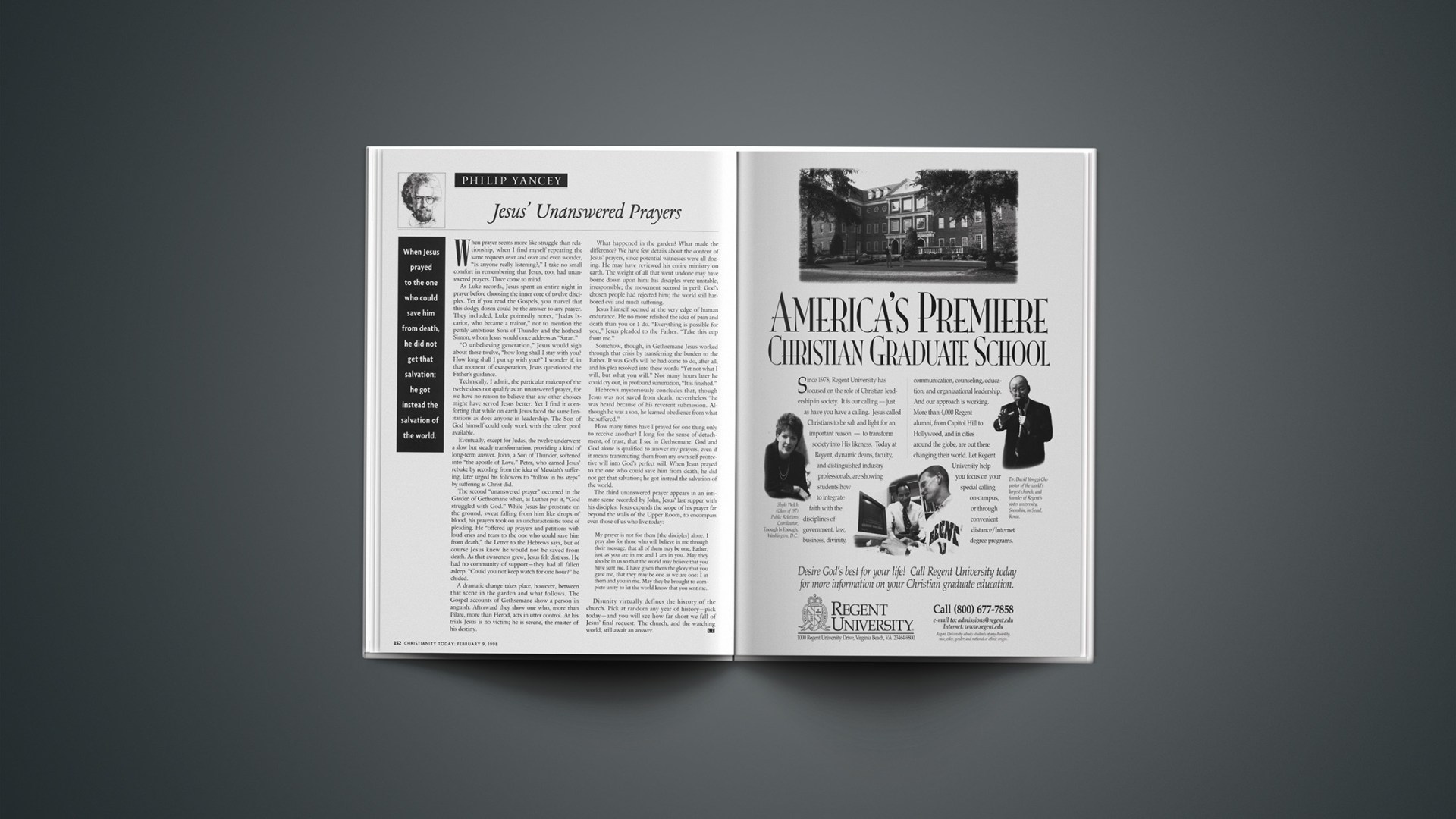When prayer seems more like struggle than relationship, when I find myself repeating the same requests over and over and even wonder, “Is anyone really listening?,” I take no small comfort in remembering that Jesus, too, had unanswered prayers. Three come to mind.
As Luke records, Jesus spent an entire night in prayer before choosing the inner core of twelve disciples. Yet if you read the Gospels, you marvel that this dodgy dozen could be the answer to any prayer. They included, Luke pointedly notes, “Judas Iscariot, who became a traitor,” not to mention the pettily ambitious Sons of Thunder and the hothead Simon, whom Jesus would once address as “Satan.”
“O unbelieving generation,” Jesus would sigh about these twelve, “how long shall I stay with you? How long shall I put up with you?” I wonder if, in that moment of exasperation, Jesus questioned the Father’s guidance.
Technically, I admit, the particular makeup of the twelve does not qualify as an unanswered prayer, for we have no reason to believe that any other choices might have served Jesus better. Yet I find it comforting that while on earth Jesus faced the same limitations as does anyone in leadership. The Son of God himself could only work with the talent pool available.
Eventually, except for Judas, the twelve underwent a slow but steady transformation, providing a kind of long-term answer. John, a Son of Thunder, softened into “the apostle of Love.” Peter, who earned Jesus’ rebuke by recoiling from the idea of Messiah’s suffering, later urged his followers to “follow in his steps” by suffering as Christ did.
The second “unanswered prayer” occurred in the Garden of Gethsemane when, as Luther put it, “God struggled with God.” While Jesus lay prostrate on the ground, sweat falling from him like drops of blood, his prayers took on an uncharacteristic tone of pleading. He “offered up prayers and petitions with loud cries and tears to the one who could save him from death,” the Letter to the Hebrews says, but of course Jesus knew he would not be saved from death. As that awareness grew, Jesus felt distress. He had no community of support—they had all fallen asleep. “Could you not keep watch for one hour?” he chided.
A dramatic change takes place, however, between that scene in the garden and what follows. The Gospel accounts of Gethsemane show a person in anguish. Afterward they show one who, more than Pilate, more than Herod, acts in utter control. At his trials Jesus is no victim; he is serene, the master of his destiny.
What happened in the garden? What made the difference? We have few details about the content of Jesus’ prayers, since potential witnesses were all dozing. He may have reviewed his entire ministry on earth. The weight of all that went undone may have borne down upon him: his disciples were unstable, irresponsible; the movement seemed in peril; God’s chosen people had rejected him; the world still harbored evil and much suffering.
Jesus himself seemed at the very edge of human endurance. He no more relished the idea of pain and death than you or I do. “Everything is possible for you,” Jesus pleaded to the Father. “Take this cup from me.”
Somehow, though, in Gethsemane Jesus worked through that crisis by transferring the burden to the Father. It was God’s will he had come to do, after all, and his plea resolved into these words: “Yet not what I will, but what you will.” Not many hours later he could cry out, in profound summation, “It is finished.”
Hebrews mysteriously concludes that, though Jesus was not saved from death, nevertheless “he was heard because of his reverent submission. Although he was a son, he learned obedience from what he suffered.”
How many times have I prayed for one thing only to receive another? I long for the sense of detachment, of trust, that I see in Gethsemane. God and God alone is qualified to answer my prayers, even if it means transmuting them from my own self-protective will into God’s perfect will. When Jesus prayed to the one who could save him from death, he did not get that salvation; he got instead the salvation of the world.
The third unanswered prayer appears in an intimate scene recorded by John, Jesus’ last supper with his disciples. Jesus expands the scope of his prayer far beyond the walls of the Upper Room, to encompass even those of us who live today:
My prayer is not for them [the disciples] alone. I pray also for those who will believe in me through their message, that all of them may be one, Father, just as you are in me and I am in you. May they also be in us so that the world may believe that you have sent me. I have given them the glory that you gave me, that they may be one as we are one: I in them and you in me. May they be brought to complete unity to let the world know that you sent me.
Disunity virtually defines the history of the church. Pick at random any year of history—pick today—and you will see how far short we fall of Jesus’ final request. The church, and the watching world, still await an answer.
Copyright © 1998 Christianity Today. Click for reprint information.










